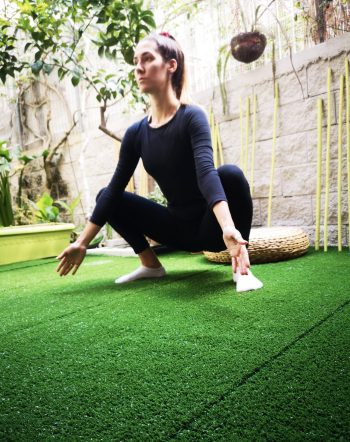[ad_1]
One pose, known as malasana, is enough to activate the metabolism, improve digestion and flexibility and more! Pilates instructor Katerina Siuka explains how this posture helps us and gives easy tips to perform it
*Written by pilates instructor Katerina Siuka
Let’s face it, for those of us who don’t live in a culture where squatting is a part of everyday life, malasana or garland pose or deep sitting can seem really strange at first. It can take a long time to get comfortable in this position, however, we perform everyday movements in the form of “sitting” (lifting a chair, sitting in the car, or picking something up off the floor), so this posture is extremely relevant. Unfortunately, in Western (and increasingly Eastern) society, our dependence on chairs, along with bad body postures, makes it more and more difficult. Have you ever noticed how babies have perfect malasana / squat form? When did we lose this ability? And how do we recover it?
Malasana activates the mechanics of the whole body. It requires mobility and stability in the ankles, knees, hips, pelvis and spine.
Start with your feet shoulder-width apart (or more) with your toes pointing outwards. Slowly bend your knees coming into a deep sitting position keeping your back straight. (see photo). Stay as long as you feel comfortable and repeat. Aim for 15 seconds 5 times a day.
RELEVANT ARTICLES

Tip: If you fall back, hold on to something. If you have difficulty pressing your heels, place a thin blanket.
Benefits
- Reduces abdominal fat
- It helps in digestion
- It keeps the joints healthy
- It activates the metabolism
- It reduces stress and anxiety
- Improves flexibility
Practicing malasana reveals a lot about your body. Pay attention to what you feel and where you feel it. You may notice asymmetries you didn’t know you had. Keep practicing and you may find that malasana is your new favorite pose. Finally, even outside of your yoga practice you may find yourself in this pose more often throughout the day!

Katerina Siuka is a certified pilates instructor (mat, props, equipment) from the GRAFTS HELLAS, LIFE PILATES and FLETCHER PILATES schools. Yoga instructor certified by the GRAFTS HELLAS school, as well as prenatal trainer (exercise and pregnancy) certified by the HUMAN MAMA school. He has been working as a pilates instructor since 2012 and specializes in rehabilitation and injury prevention. As a member of the Hellenic Basketball Federation (EEC) it also collaborates with professional athletes. He has attended a seminar on first aid, meniscus tear, chondropathy and Baker’s cyst from the POEP. “Pilates teaches us movement and movement is happiness”
